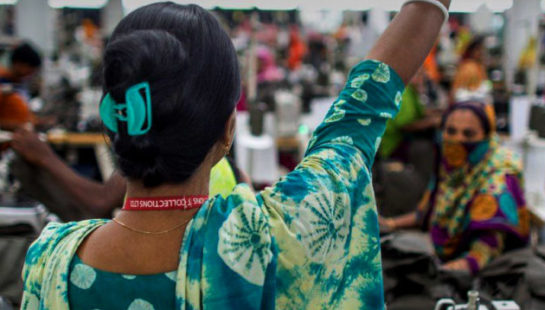Turning Everyone & Everything On Our Heads
The COVID-19 crisis has turned economies, health systems, whole industries, and even our very way of life entirely on their heads. The effects have been felt by many of us. Restrictions on our freedom of movement mean that we’re no longer flocking to the shops to buy the latest trends (we have nowhere to show off them off anyway, with social spots shut down!)
And retailers are feeling the pinch. More and more fashion companies are shutting their doors every day to protect themselves from a dip in sales, and their staff and customers from infection.
For workers in garment supply chains, who already experience disproportionately high labour rights risks every day, the economic and health risks of this crisis are particularly high. Are workers able to practice social distancing while at work, or when travelling between work and home? Can they access sick leave or annual leave in order to self-isolate? How is their employment security as companies cancel orders or default on payments?
All too often, we don’t know the answers to these questions.
What Is Transparency In The Supply Chain?
Transparency has become an important factor for businesses success in the 21st Century. It plays a key role in gaining the trust of consumers and investors alike. There is a growing, global consensus that companies have a responsibility to prevent human rights abuses. For companies new to labour rights management, taking supply chain information public is considered a first step in the right direction. Supply chain information is essential for human rights organisations, company stakeholders, and customers. Why? So we can hold companies accountable for the wellbeing of the people that produce their clothing. Additionally, we can advocate for improvements where violations are found.
The Threats Of The COVID Crisis On Supply Chains
In this time of COVID, as workers become even more vulnerable, transparency from companies about how they are working with their supply chains is more important than ever. Companies delaying payments for completed orders risk leaving suppliers at a deficit, with the burden of the lost profits falling on workers who are already, on average, paid less than minimum wage. Companies may also use Force Majeure, a legal tool that can be used to break legal contracts and back out of payments in the event of a global emergency. This might help companies to recover but has the potential to devastate global supply chains. And the workers in them.
There is also a risk of excessive work and an increase in unstable employment. The ability of factories to produce at their regular levels is changing constantly and unpredictably. China, for example, is slowly emerging from the worst point of its crisis, which erupted in December, and many garment manufacturers are re-opening. Meanwhile, the situation in Bangladesh is getting worse, with many factories closing only in the past few weeks. Companies that find their supply chains compromised because of COVID may redirect their orders to a reduced number of suppliers, placing pressure on factories to work excessive overtime hours to meet demand. The same risk is high for regions coming out of lockdown, as factories strive to make up lost time and profits by committing to large orders, with staff again forced to work excessive hours to meet deadlines. In these uncertain situations the increased use of temporary contracts and subcontracting is another risk. Such factories are more difficult to locate and monitor for labour rights standards.
The COVID crisis presents a unique challenge to social compliance. Border closures, lockdowns, and restrictions on freedom of movement mean the loss of many of the ways in which companies can protect workers from exploitation – audits, worker interviews and surveys, grievance mechanisms, and union groups. So, while the risks to workers have increased, the ability of companies to address them has actually declined.
What Next?
Many companies are still on track to report under the Australian Modern Slavery Act (MSA) this year. The MSA was created based on the idea that transparency is a strong enough tool to make positive progress on human rights issues. Companies with over $100 million in annual revenue will report on their work, tracing their supply chain and the human rights risks prevalent within it, in addition to laying out any strategies to better protect workers. Company statements, and a list of companies that do not submit one, will be published on the Australian Government website. There is currently no penalty for non-reporting. It is believed that the reputational risk to companies that either do not submit a report, or that don’t commit to bettering their labour rights management, is enough to ensure that most companies comply with the law. At this stage, the Department of Home Affairs has advised they are monitoring the COVID situation and are working to produce guidance for companies regarding how they can meet their reporting requirements in these turbulent times. This is an encouraging recognition of the validity and importance of supply chain transparency when we need it most.
Encouraging Companies To Commit To Transparency
We also encourage companies to join and aid the global effort to reduce worker exploitation in garment supply chains. Starting with being more transparent with their supply chain information. There are more and more organisations, partnerships, and programs designed to help companies meet their obligations to protect the human rights of their workers. By increasing their transparency, companies improve their credibility with investors and customers and commit to more accountability towards their workers. They also open themselves to new opportunities for collaborative approaches to global social compliance.
2020 should have been the year of supply chain transparency. Company transparency in Australia’s fashion industry has never been higher. The first Modern Slavery Statements are due. Increasingly, the Australian public are demanding information on where their clothes come from.
As this global health crisis unfolds, the likelihood of this appears evermore bleak.
But it is more important than ever.
This article is from a five-part series on ethical fashion and the global fashion industry. To see all five parts, please click here.



 Bonnie Graham,
Bonnie Graham,

 Ally Turner
Ally Turner